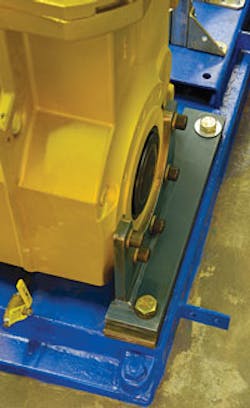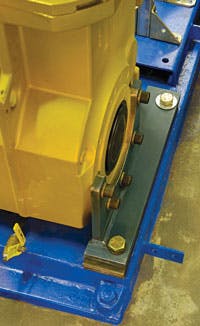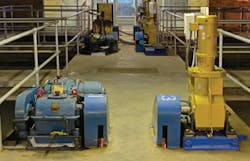Driving Efficiency: High-Performance Drives Help Ohio Water Treatment Plant Conserve Energy, Cut Costs
By Allison Carroll
More than half a million people in the city of Toledo, Ohio, and the surrounding area use an average of 70 million gallons of water per day (MGD), and it's the responsibility of the city's Department of Public Utilities water treatment plant to make sure the water pumped from Lake Erie is safe.
But with aging and outdated equipment being used in a key purification process, that job was getting more difficult. So when funds became available for an upgrade, plant management turned to a trusted local distributor to help them find a high-performance solution that was easy to use, easy to maintain and energy efficient.
Andy McClure, plant administrator for the Collins Park facility, explained that 12 mechanical variable speed drive systems (or PIVs), installed in 1941, power fully-submerged paddles on a 60-foot-long shaft in four large treatment basins. These paddles stir chemicals added in the flocculation process, one of the most common steps in removing contaminants from drinking water. The mechanical system was an early way to achieve variable speed control, but McClure said the PIVs were well past their prime.
"Our maintenance crews have done a terrific job keeping the PIVs running, but it's becoming more and more difficult to get parts," said McClure. "And because it's a mechanical system, we are stuck with whatever speed it was on when it shut down, which makes it a little bit of an adventure when we start it back up. It was time for us to move to new technology."
Because the flocculation process needs to be carefully controlled, McClure required a solution that would offer a lot of torque, even at low RPMs. But he was finding it difficult to determine just which gearbox would be the best fit for the application. After a first attempt at a retrofit didn't work, McClure reached out to local distributor Binkelman Corporation for assistance.
"I needed help to find the right products, making sure the gear reducer had the right service factor and the right reduction ratio for the range we needed," said McClure, "I wanted help to find a packaged system that would allow us to precisely control the speed of the paddles during the first, second and third pass."
The help McClure needed came from Binkelman's Scott Tomasewski. Based on his experience retrofitting old mechanical variable speed drives for other customers, Tomasewski was confident that a packaged Baldor•Dodge® solution would be the best fit. With the go-ahead from McClure, Tomasewski and Dodge Field Sales Engineer Tim Bachler got to work to identify correct sizing and gear ratios.
"Basically, Tim and I reviewed the application and the old unit and reverse- engineered a new solution that would meet the torque requirements," said Tomasewski. They proposed a Quantis® Gold package: a Dodge Quantis RHB (right-angle helical bevel) gearbox with a Baldor Super-E® premium efficient motor, along with a VFD (variable frequency drive). "Not only is this an energy-efficient package, it's also one that is easy to order and easy to install," he said. "It was good news when we learned that this was the package that was selected through a competitive bidding process."
McClure was also convinced this was the right solution, but since this upgrade was part of a Better Buildings program using Energy Efficiency and Conservation Block Grant money, funded by the American Recovery and Reinvestment Act (ARRA), the equipment selected had to meet program standards. Christopher Green, energy efficiency and sustainability manager for the city of Toledo, said they were pleased that the package fit all the criteria.
"The program seeks out projects that result in reduced energy usage, and the Baldor solution does that," said Green. And since these products were manufactured in the United States, they complied with ARRA's ‘buy American' provisions. "The city of Toledo also had a ‘local preference' worked into the specs," said Green, "so by working with Binkelman, we are also supporting our local community."
But there was one more hurdle to overcome. The Quantis Gold package needed to be installed in the same spot where the old drives sat. McClure said that the solution Baldor provided -- fabricated steel brackets -- made the installation quick and easy.
"It turned out to only be a one-day job because we didn't have to do any concrete work or drilling or tapping," said McClure. "The new brackets bolted right into the old equipment base, which was very convenient. This was really a drop-in replacement."
Once it was installed, McClure noted that the benefits of the new package were obvious, like the ability to achieve precise control. He said the drives are a hit with the maintenance staff because they are user-friendly, which makes it easy to vary the speed of the flocculators. But it's the way the drives can help them prevent problems that really grabbed McClure's attention.
"These drives allow us to plug in and fine-tune the current so the drive knows exactly what the motor needs," said McClure. "So, if there is a problem that causes an inrush of current, the drive will shut down to prevent damage, not only to the motor but to all of the equipment. Protecting the system like this means a lot less maintenance."
The city is also pleased with the efficiency of the Baldor solution. Based on current prices per kilowatt hours, Green has calculated that the city will see an annual electrical cost savings of $7,569 when all 12 units are installed. Year after year, those savings will add up. But while this project fell under the umbrella of energy efficiency, he pointed out that there are also savings for the city beyond energy.
"Because these products are nearly maintenance free, they will help us reduce downtime and we'll become more efficient," explained Green. "This project is a great example of what we call ‘soft savings,' which may be a bigger part of the story. I would say the soft savings on this project are huge compared to the energy savings."
It's clear to McClure and his team at the Collins Park facility that all of the savings add up to a successful project. But, he also stated that the project's success is measured in more than just cost savings. "Our goal is to better serve our community," he said. "This Baldor solution provides consistent and reliable control, which will make it easier for us to ensure and maintain water quality for years to come."
About the Author: Allison Carroll is the water/wastewater industry account manager for Baldor Electric, a member of the ABB Group. She is a member of the Hydraulic Institute and has hosted several pump system optimization and energy-efficiency courses.
More WaterWorld Current Issue Articles
More WaterWorld Archives Issue Articles


